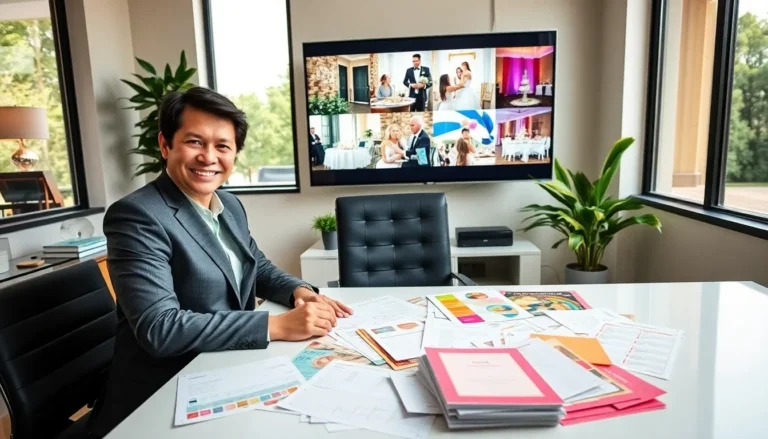Science experiments spark curiosity and bring out the inner Einstein in every 5th grader. STEM projects offer the perfect blend of hands-on learning and scientific discovery that kids crave while building essential problem-solving skills for the future. From creating miniature robots to designing eco-friendly solutions these projects make learning fun and memorable.
Teachers and parents looking for engaging STEM activities will find that 5th grade represents a sweet spot where students can tackle more complex challenges while maintaining their natural enthusiasm for discovery. These age-appropriate projects encourage critical thinking teamwork and creativity all while aligning with educational standards. Whether it’s constructing a working model of the solar system or programming a basic computer game students develop valuable skills that’ll serve them well beyond the classroom.
Table of Contents
ToggleUnderstanding STEM Education in Fifth Grade
Fifth grade STEM education integrates science, technology, engineering and mathematics into hands-on learning experiences. Students at this age demonstrate increased capacity for abstract thinking and complex problem-solving abilities.
Key Components of 5th Grade STEM
- Science exploration focuses on earth systems, physical sciences and life cycles
- Technology integration includes coding basics, digital tools and simple robotics
- Engineering concepts cover design thinking, prototype development and testing
- Mathematical applications emphasize data analysis, measurements and calculations
Academic Standards and Learning Objectives
| STEM Area | Core Skills Developed | Success Metrics |
|---|---|---|
| Science | Scientific Method | 85% comprehension |
| Technology | Digital Literacy | 75% proficiency |
| Engineering | Design Process | 80% project completion |
| Mathematics | Problem Solving | 90% accuracy rate |
Developmental Readiness
Fifth graders possess enhanced cognitive abilities that enable them to:
- Process multi-step instructions for complex projects
- Work independently on extended investigations
- Apply mathematical concepts to real-world scenarios
- Collaborate effectively in team environments
- Document observations with detailed accuracy
Cross-Disciplinary Integration
STEM learning in fifth grade connects across subjects through:
- Writing detailed lab reports using language arts skills
- Measuring and graphing data using mathematical tools
- Creating digital presentations of project findings
- Applying social studies concepts to engineering challenges
- Incorporating artistic elements into design solutions
These structured learning experiences prepare students for advanced STEM concepts while maintaining age-appropriate engagement levels.
Simple Machine Engineering Projects
Simple machines form the foundation of engineering principles, offering 5th-grade students hands-on experience with mechanical advantage concepts. These projects combine physics fundamentals with creative problem-solving opportunities.
Building Pulley Systems
Pulley systems demonstrate mechanical advantage through practical applications in lifting heavy objects. Students create working models using common materials like rope, wooden spools, dowels for axles, and various weighted objects. A basic single pulley setup lifts 5 pounds of weight, while a compound pulley system reduces the effort by 75%. The project incorporates measurement skills as students calculate load weights, mechanical advantage ratios, and distance relationships. They test different configurations including fixed pulleys, movable pulleys, and block-and-tackle systems to compare efficiency rates.
Designing Lever-Based Games
Lever-based games transform physics concepts into engaging activities that showcase force multiplication. Students construct catapults using wooden boards, pivot points, and projectile objects to explore mechanical advantage. The games incorporate distance markers, target zones, and scoring systems based on accuracy. A typical project setup includes three lever classes with varying fulcrum positions demonstrating mechanical advantages of 2:1, 3:1, and 4:1 ratios. Students document launch angles, distances achieved, and force applied to understand leverage principles through direct experimentation.
Fun Electronics Experiments
Electronics experiments introduce 5th graders to fundamental electrical concepts through engaging hands-on activities. These projects combine scientific principles with practical applications to demonstrate how electrical circuits power everyday devices.
Creating Basic Circuits
Students create functional circuits using copper tape, LED lights, coin cell batteries, switches, and paper to explore electrical energy flow. A parallel circuit configuration illuminates multiple LED lights while maintaining consistent brightness levels across components. Series circuits demonstrate voltage division principles by connecting LEDs in sequence, with each component receiving a portion of the total voltage. The circuit-building process teaches core concepts:
- Connecting positive terminals (anode) to negative terminals (cathode)
- Testing conductivity of different materials
- Measuring voltage using multimeters
- Identifying open versus closed circuits
- Troubleshooting faulty connections
Building a Simple Motor
A homemade electric motor demonstrates electromagnetic principles using common materials like copper wire, magnets, paperclips, and a D-cell battery. Students wind copper wire into a coil shape to create an electromagnet that interacts with permanent magnets. The motor assembly includes:
- Mounting the wire coil on a central shaft
- Positioning permanent magnets around the coil
- Creating a commutator from stripped wire ends
- Attaching battery leads to complete the circuit
- Adjusting components for smooth rotation
The completed motor converts electrical energy to mechanical energy, spinning at 300-400 rotations per minute when properly balanced.
Environmental Science Activities
Environmental science activities engage 5th-grade students in hands-on exploration of ecological concepts while promoting environmental stewardship. These projects combine scientific inquiry with real-world applications to solve environmental challenges.
Water Filtration Challenge
The water filtration challenge introduces students to water purification processes through practical experimentation. Students create filtration systems using layers of sand, gravel, activated charcoal, cotton balls, coffee filters to remove impurities from contaminated water samples. Data collection involves measuring water clarity, pH levels, and particle content before and after filtration. This experiment teaches:
- Testing procedures for water quality assessment
- Documentation of filtration effectiveness using scientific measurements
- Analysis of different filtering materials’ performance
- Understanding of large-scale water treatment applications
Solar-Powered Solutions
Solar power experiments demonstrate renewable energy principles through interactive projects. Students construct solar ovens using cardboard boxes, aluminum foil, black paper to harness solar energy for heating. Temperature monitoring reveals energy conversion efficiency at different times of day. Key learning components include:
- Measurement of temperature changes using digital thermometers
- Recording of solar intensity effects on heating rates
- Design modifications to improve energy collection
- Documentation of weather conditions impact on performance
- Calculation of energy conversion percentages
These activities incorporate real data collection techniques while connecting students to sustainable energy concepts.
Math-Based Design Projects
Mathematical design projects combine creativity with precise calculations to develop 5th graders’ spatial reasoning abilities. These hands-on activities integrate geometry principles with artistic expression to create meaningful learning experiences.
Geometric Art Installations
Students create large-scale art installations using geometric shapes, measurements, and mathematical patterns. The process starts with drafting designs on graph paper using geometric principles like symmetry, tessellation, and proportion. Each installation incorporates specific shapes: triangles, hexagons, squares arranged in precise mathematical sequences. Students calculate perimeters, areas, and angles while assembling their structures using materials like cardboard, wood, or recycled items. A typical installation measures 3-4 feet in height with multiple interconnected geometric forms displaying mathematical concepts such as the Fibonacci sequence or fractal patterns.
Scale Model Construction
Scale modeling introduces students to ratio concepts through practical applications in architectural design. Each project begins with selecting a real structure to replicate at 1:24 or 1:48 scale. Students measure dimensions, convert measurements, and create detailed blueprints using grid paper. The construction phase involves:
- Building foundations using precise measurements converted from actual building specifications
- Creating structural elements with calculated proportions using balsa wood or foam board
- Adding architectural details scaled exactly to match the original structure
- Incorporating interior spaces with accurate room dimensions
The completed models serve as three-dimensional demonstrations of mathematical scaling principles applied to real-world architecture.
Coding and Robotics Projects
Coding and robotics projects introduce 5th-grade students to computer science fundamentals through hands-on programming experiences. These activities combine logical thinking with physical computing to create interactive solutions.
Block Programming Basics
Block programming introduces students to coding concepts using visual programming interfaces like Scratch or Code.org. Students drag and drop pre-made code blocks to create sequences, loops and conditional statements that control on-screen characters. The platform enables creation of interactive stories, animations and games by connecting color-coded blocks that represent different programming functions. Projects include programming a virtual pet’s behaviors, designing platformer games and building math quiz applications. This visual approach removes syntax barriers while teaching core programming concepts like variables, functions and debugging.
Robot Maze Navigation
Robot maze navigation projects pair physical robots with student-written code to solve spatial challenges. Students program robots like Sphero or Ozobots to navigate through custom-built mazes using sensors and basic algorithms. The activity starts with simple straight-line paths and progresses to complex mazes requiring multiple turns, loops and conditional logic. Students measure distances, calculate angles and experiment with different coding solutions to optimize their robot’s path through the maze. Data from light, proximity and rotational sensors provides immediate feedback as students iterate their code to achieve successful navigation outcomes.
Technology Integration Ideas
Technology integration enhances STEM learning through interactive digital tools that promote engagement and creativity. These projects combine technical skills with artistic expression, enabling 5th graders to explore modern technological applications.
Digital Storytelling
Digital storytelling transforms traditional narratives into multimedia presentations using apps like Adobe Spark or WeVideo. Students create animated science documentaries explaining concepts such as the water cycle or planetary motion through video clips, images, narration elements. The process involves storyboarding, script writing, recording voiceovers, adding background music tracks, editing transitions. Students learn digital literacy skills while producing 2-3 minute videos that demonstrate their understanding of scientific principles. This project connects technology with communication abilities as students research topics, organize information logically, select appropriate media assets to support their message.
3D Design Projects
3D design introduces students to spatial modeling through platforms like Tinkercad or SketchUp. Students create virtual prototypes of simple machines, architectural models or geometric sculptures using computer aided design tools. The modeling process teaches measurement, proportion, scale concepts as students manipulate 3D shapes in digital space. Projects include designing phone stands, creating custom game pieces, modeling building structures. Students print their designs using 3D printers to produce tangible objects from their digital creations. This hands-on experience connects computer modeling skills with engineering principles through an iterative design process.
Conclusion
STEM projects for 5th graders unlock a world of discovery where science technology engineering and mathematics come together in exciting ways. These hands-on activities create meaningful learning experiences that extend far beyond the classroom walls. Students develop critical thinking skills teamwork abilities and a deeper understanding of real-world applications.
The diverse range of projects from simple machines to coding empowers students to explore their interests while building a strong foundation in STEM subjects. As they tackle these engaging challenges they’re not just learning – they’re preparing for future academic success and developing skills that will serve them throughout their lives.







